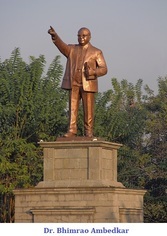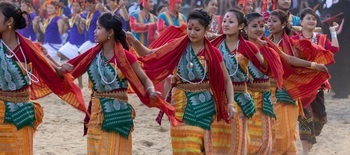

Scheduled Caste, Scheduled Tribes and Other Backward Castes are political legal categories of Indian population. Historically, these groups have been deprived of their rights and social recognition which encouraged the founders of the Indian Constitution to provide Constitutional recognition to these groups to ensure their safety. In this article, we will study these groups through an anthropological lens.
The Scheduled Caste has its roots in the fourfold varna system. The term Scheduled caste, initially coined by Simon Commission and later used in Government of India Act 1935, is a legal political term. The phrase "scheduled castes" refers to those ethnic or racial groupings that belonged to the lowest strata of the caste systems. The majority of "untouchables" were considered as Scheduled Castes. The higher caste viewed the Scheduled Caste as untouchable and polluting because of their alleged polluting functions such as scavenging, cremation, skinning, and hiding. Moreover, due to their 'dark complexion' they were placed at the bottom of the varna system.
‘Depressed class’ is a phrase coined by Dr. Ambedkar to describe those types of groups who are underprivileged, exploited, and socially, ritualistically, or spiritually degraded. They are also referred to as "Harijans" (the children of God) which is a term coined by Mahatma Gandhi. The term "dalit" is now used to refer to scheduled caste. The Scheduled Castes or Untouchables, however, are not a uniform group. They are numerically separated based on the untouchability criterion and internally differentiated based on profession.
Dr. Ambedkar to describe those types of groups who are underprivileged, exploited, and socially, ritualistically, or spiritually degraded. They are also referred to as "Harijans" (the children of God) which is a term coined by Mahatma Gandhi. The term "dalit" is now used to refer to scheduled caste. The Scheduled Castes or Untouchables, however, are not a uniform group. They are numerically separated based on the untouchability criterion and internally differentiated based on profession.
Their distinctiveness also lies in their food habits, culture, traditions, symbolic rituals, language, occupation and clothing.
According to anthropological study tribal groups are those groups that have unique cultural identity and are an ethnic group or endogamous group that depends on kinship. They have identified some regions like −
The Himalayan Region includes, Tarai area of Uttar Pradesh, states such as Himachal Pradesh, Jammu and Kashmir. Some of the tribes living in this region are Khasi, Toto, Lepcha, Chauma, Abor, Rabha, Naga, etc.
The Middle Indian Region includes areas of West Bengal, Bihar, Madhya Pradesh, Telangana, Orissa and Andhra Pradesh.Tribes living in these regions are Oraon, Gond, Munda, Ho, Lodha, Santal, Bhil, etc.
The Western India Region includes Gujarat, Maharashtra, Goa, Rajasthan and Dadar and Nagar Haveli. Tribes living in these regions are Mina, Koli, Tathawa, Saharia, etc.
The South India Region includes Tamil Nadu, Kerala, Karnataka and tribes are Uralis, Toda, Kurumba, Mala, etc.
The Islands include Andaman and Nicobar. Lakshadweep with tribes like Jawra, Aminidivi, Koyas, etc.
Most of the tribes speak their own language or the language of their neighbouring non-tribal community. It is estimated that around 123 tribes speak one single language. Some of them use the Roman script or Devanagiri script. Some tribes who belong to different language families also inhabit different geographical areas. For example, The Santhals speak Santali which is a Munda language with OlChiki script and live in West Bengal, Orissa and Bihar.
It is estimated that around 123 tribes speak one single language. Some of them use the Roman script or Devanagiri script. Some tribes who belong to different language families also inhabit different geographical areas. For example, The Santhals speak Santali which is a Munda language with OlChiki script and live in West Bengal, Orissa and Bihar.
Tribes are classified to practise certain forms of livelihood like hunting, pastoral and cattle herding, folk art, hill-cultivation like jhum but to advance in resources and infrastructure Scheduled Tribes also practise other forms of livelihood like non-tribals.
Socially disadvantaged shudra castes are included in the constitutional category known as "Other Backward Classes," which is used to describe them. This segment of the population is made up of castes that are situated in the middle of the conventional stratification systems. As a result, it represents a social tier in between the twice born and the untouchable. These groups are less qualified than the traditionally privileged castes in terms of education and employment. Their untouchability and isolation were never a problem, but historically, their inferiority to the upper castes was justified. According to Marc Galenter, it differs from state to state in composition.
The first commission for the other backward classes found that the other backward classes made up 31.8% of the population. Their representation in the population is 52%, according to the second commission for them, also referred to as the Mandal Commission.
Reservation is offered to Scheduled Castes (SCs), Scheduled Tribes (STs), and Other Backward Classes (OBCs) at the rates of 15%, 7.5%, and 27%, respectively, in cases of direct recruitment on an all-India basis through open competition. This is in accordance with the most recent guidelines. The proportion established is 16.66% for SCs, 7.5% for STs, and 25.84% for OBCs in cases of direct recruitment on an all-India basis without an open competition.
The percentage of reservation for SC/ST/OBC is typically established on the basis of their demographic proportion in the relevant States/Union Territories in the case of direct recruitment to Group C jobs, which typically attract candidates from a locality or a region.
According to Article 15(4), the State is permitted to make any provisions for the advancement of socially and economically disadvantaged classes, including SCs and STs.
The second exemption to Article 16 (1) and Article 16 is Clause (4). (2). The State is given the authority to make any provisions necessary for backward class persons who are not appropriately represented in State-run services under Article 16(4). Regarding reservations for government job appointments, provisions have been made.
Hence, we can summarise that the composition, lifestyle and socio-economic conditions of the SC, ST and OBCs are historically defined and classified. Anthropological examination of these groups have helped the Indian governments from time to time in recognizing their distinctiveness and creating provisions for ensuring their wellbeing, security and upliftment.
Q1. Which Indian states have the highest and lowest tribal population?
Ans. Madhya Pradesh has the highest tribal population. Maharashtra and Orissa are the second most tribal populated states in India. The Indian states with the lowest tribal population are Uttar Pradesh, Tamil Nadu and Bihar.
Q2. What are the five language families of the tribes?
Ans. The five language families of the tribe include Andamanese, Austro-Asiatis, Dravidian, Indo-Aryan and Tibeto-Burman.
Q3. What is ‘cultural relativism’?
Ans. According to anthropologists, no culture can be considered as superior than the other for studying any cultures across the globe. This is cultural relativism.